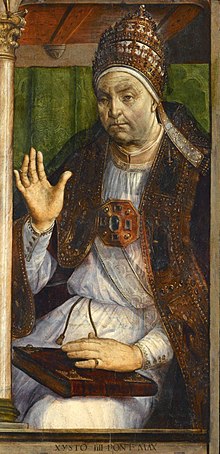
Back Pous Sixtus IV Afrikaans سيكتوس الرابع Arabic سيكتوس الرابع ARZ Сікст IV Byelorussian Сыкст IV (папа рымскі) BE-X-OLD Сикст IV Bulgarian Sikstus IV Breton Papa Siksto IV BS Sixt IV Catalan Gáu-huòng Sixtus 4-sié CDO
Sixtus IV | |
|---|---|
| Bishop of Rome | |
 Portrait of Sixtus IV by van Gent and Berruguete, c. 1474 – 76 (oil on panel, 116 × 56.4 cm, Louvre) | |
| Church | Catholic Church |
| Papacy began | 9 August 1471 |
| Papacy ended | 12 August 1484 |
| Predecessor | Paul II |
| Successor | Innocent VIII |
| Previous post(s) |
|
| Orders | |
| Consecration | 25 August 1471 by Guillaume d'Estouteville |
| Created cardinal | 18 September 1467 by Paul II |
| Personal details | |
| Born | Francesco della Rovere 21 July 1414 |
| Died | 12 August 1484 (aged 70) Rome, Papal States |
| Signature | |
| Coat of arms |  |
| Other popes named Sixtus | |
| Papal styles of Pope Sixtus IV | |
|---|---|
 | |
| Reference style | His Holiness |
| Spoken style | Your Holiness |
| Religious style | Holy Father |
| Posthumous style | None |
Ordination history of Pope Sixtus IV | |||||||||||||||
|---|---|---|---|---|---|---|---|---|---|---|---|---|---|---|---|
| |||||||||||||||
| |||||||||||||||

Pope Sixtus IV (or Xystus IV,[1] Italian: Sisto IV; born Francesco della Rovere; 21 July 1414 – 12 August 1484) was head of the Catholic Church and ruler of the Papal States from 9 August 1471 until his death. His accomplishments as pope included the construction of the Sistine Chapel and the creation of the Vatican Library. A patron of the arts, he brought together the group of artists who ushered the early Renaissance into Rome with the first masterpieces of the city's new artistic age.
Sixtus founded the Spanish Inquisition through the bull Exigit sincerae devotionis affectus (1478), and he annulled the decrees of the Council of Constance. He was noted for his nepotism and was personally involved in the infamous Pazzi conspiracy, a plot to remove the Medici family from power in Florence.[2]